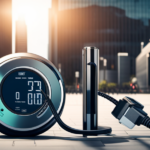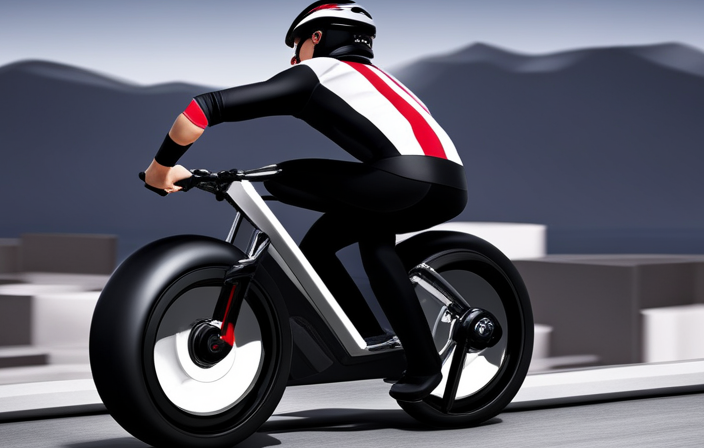Juxtaposing the convenience of electric bikes with the ever-increasing cost of fuel, many are turning to these eco-friendly alternatives.
But how much does it really cost to charge an electric bike? In this article, I will delve into the charging basics, calculate the electricity costs, and explore the factors that affect the overall charging expenses.
By analyzing battery capacity, electricity rates, and government incentives, we will uncover the true cost of owning and charging an electric bike.
Join me as we navigate the world of electric bike charging and determine if it’s worth the investment.
Key Takeaways
- Understanding the basics of electric bike charging is essential for determining the cost of charging an electric bike.
- Factors such as electricity rates, charging efficiency, battery age, and off-peak charging can significantly impact the cost of charging an electric bike.
- Battery capacity plays a crucial role in determining the distance a bike can travel before requiring a recharge, as well as its overall performance and charging costs.
- It is important to find a balance between charging frequency and battery lifespan, considering factors such as optimal charging level, battery age, and manufacturer’s guidelines.
Understanding Electric Bike Charging Basics
Understanding the basics of electric bike charging is essential to know how much it’ll cost.
Calculating charging efficiency is a crucial factor in determining the cost. Charging efficiency refers to how effectively the battery is recharged during the charging process. It is important to note that not all electric bike chargers have the same efficiency, with some being more efficient than others.
Additionally, the impact of charging on battery lifespan should be considered. Frequent and improper charging can reduce the overall lifespan of the battery. Therefore, it is recommended to follow the manufacturer’s guidelines for charging to ensure optimal battery health.
Now, let’s delve into calculating electricity costs for charging, where we will explore the different factors that contribute to the overall cost.
Calculating Electricity Costs for Charging
To calculate the price of powering up your e-bike, you can simply multiply the electricity rate per kilowatt-hour by the amount of energy consumed during the charging process. This straightforward calculation allows you to evaluate the charging efficiency of your electric bike and determine your charging costs accurately.
Here are some key factors to consider when calculating electricity costs for charging:
- Charging Efficiency: Some energy is lost during the charging process, so it’s essential to factor in the efficiency of your charger and battery to get an accurate cost estimate.
- Battery Age: As your battery ages, its charging efficiency may decrease, resulting in higher electricity costs over time. It’s important to consider the impact of battery age on your charging expenses.
By considering these factors, you can get a better understanding of how much it costs to charge your electric bike.
In the next section, we will discuss the various factors that can affect your charging costs.
Factors Affecting Charging Costs
Factors that can impact the price of charging an e-bike include the electricity rate, charging efficiency, battery age, and other variables.
When calculating charging expenses, it is important to consider the electricity rate, which can vary depending on your location and the time of day. Charging efficiency is another crucial factor, as it determines how much energy is actually being transferred to the battery. Older batteries may also require more energy to charge, resulting in higher costs.
To minimize charging costs, you can consider charging during off-peak hours or using a time-of-use electricity plan. Additionally, keeping your battery well-maintained and at optimal temperature can improve charging efficiency and reduce costs.
Understanding these factors and implementing these tips can help you manage and minimize the expenses associated with charging your e-bike.
Now, let’s delve into the next section about battery capacity.
Battery Capacity
When it comes to your e-bike, you’ll want to consider the battery capacity as it directly affects the distance you can travel before needing to recharge. The battery capacity is measured in watt-hours (Wh) and determines how much energy your e-bike can store. A higher battery capacity means you can travel longer distances without needing to recharge.
However, it’s important to note that the battery lifespan is also influenced by its capacity. The more you use and recharge the battery, the shorter its lifespan will be.
Additionally, the availability of charging infrastructure is crucial for e-bike owners. Having access to charging stations can make it more convenient and efficient to charge your e-bike when needed.
Considering these factors, it’s important to understand the battery capacity and its implications for your e-bike’s overall performance and charging costs.
Moving on to electricity rates, let’s discuss the next aspect of charging your e-bike.
Electricity Rates
Considering the importance of electricity rates, it’s crucial to be mindful of how much you’re spending on charging your e-bike. Electricity consumption is a key factor in determining the cost of charging. Different e-bike models have varying energy requirements, so it’s important to check the specifications provided by the manufacturer.
Additionally, the cost of electricity can vary depending on your location and the rates offered by your utility provider. To determine the most cost-effective option, it’s advisable to compare electricity rates from different providers and calculate the estimated cost per kilowatt-hour (kWh). By doing so, you can make an informed decision and minimize the expenses associated with charging your e-bike.
Transitioning into the subsequent section on charging frequency, it’s essential to consider how often you’ll be charging your e-bike.
Charging Frequency
To determine the optimal charging frequency for your e-bike, you should take into account your daily commuting needs and the battery capacity of your bike. Charging efficiency plays a crucial role in this decision.
Generally, it is recommended to charge your electric bike when the battery level drops to around 20-30%. This allows for a more efficient charging process and prevents overcharging. However, it is important to note that charging too frequently can have a negative impact on the battery’s lifespan. As batteries age, their capacity gradually decreases, resulting in reduced range per charge. Therefore, finding the right balance between charging frequency and battery age is essential.
Now, let’s move on to the next section to discuss the charging time and its significance in maintaining the longevity of your e-bike’s battery.
Charging Time
If you want to maintain the longevity of your e-bike’s battery, it’s important to be mindful of the charging time. Calculating the charging time is crucial to ensure that you don’t overcharge or undercharge your battery. The charging time can vary depending on factors such as the battery capacity, charger output power, and the current charge level of the battery.
It is recommended to refer to the manufacturer’s guidelines for the specific charging time of your e-bike. Additionally, it’s worth noting that fast charging may have an impact on the overall battery life. While it can be convenient to charge your e-bike quickly, frequent fast charging may lead to a shorter battery lifespan. Therefore, it’s important to strike a balance between the charging time and the battery’s health.
In the subsequent section, we will compare the charging costs of e-bikes to the fuel costs of traditional bikes, providing a comprehensive understanding of the economic aspects.
Comparing Charging Costs to Fuel Costs
To compare the charging costs of an e-bike to the fuel costs of a traditional bike, you can evaluate the economic aspects.
When it comes to evaluating cost effectiveness, electric bikes have a clear advantage. The cost of charging an electric bike is significantly lower compared to the cost of fueling a traditional bike. Electricity is generally cheaper than gasoline or diesel, and the efficiency of electric bikes ensures that you get more mileage for your money.
Not only does charging an electric bike save you money, but it also has a positive impact on the environment. By using electricity as a fuel source, you reduce greenhouse gas emissions and contribute to a cleaner and more sustainable future.
With these economic and environmental benefits in mind, let’s explore some tips for minimizing charging expenses.
Tips for Minimizing Charging Expenses
One way you can reduce your charging expenses is by utilizing energy-saving techniques. Here are some tips for minimizing your charging expenses while also minimizing your environmental impact and optimizing charging speed:
-
Use a smart charger: A smart charger can adjust the charging rate based on the battery’s needs, ensuring efficient charging and preventing overcharging.
-
Charge during off-peak hours: Charging your electric bike during off-peak hours can often result in lower electricity rates, saving you money on your charging expenses.
-
Optimize your charging habits: Avoid charging your electric bike to full capacity if you don’t need it. Partial charges can be more efficient and cost-effective.
By implementing these energy-saving techniques, you can reduce your charging expenses while also minimizing your environmental impact and optimizing charging speed.
Charging during off-peak hours is another strategy that can further help you save on your charging costs.
Charging during Off-Peak Hours
Charging during off-peak hours can result in lower electricity rates, helping you save on your charging expenses. By taking advantage of this time frame, you can maximize your charging efficiency and implement cost-saving strategies. During off-peak hours, the demand for electricity is lower, leading to reduced rates. This means that the cost per kilowatt-hour (kWh) is often cheaper compared to peak hours. To give you an idea of the potential savings, take a look at the table below:
| Time of Day | Electricity Rate (per kWh) | Savings |
|---|---|---|
| Off-Peak | $0.10 | 30% |
| Peak | $0.15 |
As you can see, charging during off-peak hours can result in significant savings of up to 30%. This strategy not only helps you cut down on charging expenses, but it also promotes more efficient electricity usage. By utilizing regenerative braking, you can further enhance your electric bike’s energy efficiency and reduce overall energy consumption.
Utilizing Regenerative Braking
When it comes to charging an electric bike during off-peak hours, there is another technique that can further enhance efficiency and reduce costs: utilizing regenerative braking. This innovative feature allows the bike to convert some of the energy dissipated during braking into electricity, which is then used to recharge the battery.
By harnessing this technology, not only can you extend the range of your electric bike, but you can also reduce the amount of external charging needed. However, it is important to note that the efficiency of regenerative braking can vary depending on factors such as speed and terrain.
Additionally, while regenerative braking can help to conserve energy and reduce costs, it may have a slight impact on the overall lifespan of the battery. Therefore, it is crucial to strike a balance between utilizing regenerative braking and implementing optimal battery maintenance practices.
Optimal Battery Maintenance
To ensure your battery lasts as long as possible, it’s important to follow optimal maintenance practices. Battery longevity is greatly influenced by how you charge and maintain your electric bike’s battery.
One key factor is avoiding overcharging or undercharging the battery. It’s best to charge the battery to around 80% and avoid letting it drop below 20%. This helps to prolong the battery’s life and maintain its overall capacity.
Additionally, it’s recommended to avoid exposing the battery to extreme temperatures, as this can also affect its longevity.
Another important aspect is understanding battery charging cycles. A full charging cycle is when the battery goes from 0% to 100% and then back to 0% again. It’s crucial to minimize the number of complete charging cycles, as they contribute to battery degradation over time.
By following these optimal maintenance practices, you can ensure your electric bike’s battery lasts longer and performs optimally.
Now, let’s explore alternative charging options.
Exploring Alternative Charging Options
If you’re looking for different ways to power up your e-bike’s battery, there are alternative charging options you can consider. These portable charging options provide flexibility and convenience, allowing you to recharge your battery on the go.
One option is a portable power bank specifically designed for e-bikes. These compact devices can easily fit in your backpack and provide a quick boost to your battery when needed.
Another innovative solution is a dynamo charger, which harnesses the energy generated by pedaling to charge your battery while you ride. This not only provides a sustainable way to charge your e-bike, but also ensures that you always have power available.
Transitioning into the subsequent section about ‘solar charging,’ there is another option that utilizes the power of the sun to charge your e-bike’s battery.
Solar Charging
Consider utilizing solar charging as an efficient and eco-friendly way to power up your e-bike’s battery. With advancements in technology, portable solar panels have become a viable option for charging electric bikes. These panels are designed to be lightweight and compact, making them easy to carry during your outdoor adventures.
By integrating a solar panel into your e-bike, you can harness the power of the sun to charge your battery while on the go. This not only reduces your reliance on traditional charging methods but also minimizes your carbon footprint. However, it’s important to note that solar charging may not be as fast or as consistent as charging from a traditional power source.
Nevertheless, it provides a convenient and sustainable solution for powering your e-bike. Moving on to portable charging stations, they offer another option for charging your e-bike battery without the need for a traditional power outlet.
Portable Charging Stations
Portable charging stations provide an alternative solution for conveniently powering up your e-bike battery. These portable charging solutions offer several advantages, such as fast charging capabilities and the ability to charge your electric bike on the go.
With a portable charging station, you no longer have to worry about finding a traditional power outlet or waiting for hours to charge your e-bike. These compact stations are designed to be lightweight and easily transportable, allowing you to charge your bike wherever you are.
Fast charging technology ensures that your e-bike battery can be fully charged in a shorter amount of time, providing more convenience and flexibility for your rides. By utilizing portable charging stations, you can enjoy the benefits of quick charging and continue exploring without any interruption.
Transitioning into evaluating the long-term savings of electric bikes, it is important to consider the cost-effectiveness of these innovative transportation options.
Evaluating the Long-Term Savings of Electric Bikes
When it comes to evaluating the long-term savings of electric bikes, there are a few factors to consider. One important aspect is the battery lifespan. Electric bike batteries typically last for around 2-5 years, depending on usage and quality. It’s essential to factor in the cost of replacing the battery when considering the overall cost of owning an electric bike.
Another aspect to consider is the cost comparison between electric bikes and traditional bikes or cars. While electric bikes may have a higher initial cost, they can save you money in the long run. With the rising cost of fuel and the maintenance expenses associated with cars, electric bikes offer a more affordable transportation option.
Additionally, electric bikes require minimal ongoing maintenance, further reducing costs. They don’t need oil changes, engine tune-ups, or regular visits to the mechanic. This simplicity translates into long-term savings.
Considering the environmental benefits of electric bikes, let’s explore how they contribute to sustainable transportation.
Considering the Environmental Benefits
You should take into account the environmental benefits of electric bikes when evaluating their long-term savings.
Electric bikes have a significantly lower environmental impact compared to conventional vehicles. They produce zero emissions while riding, reducing air pollution and greenhouse gas emissions. By promoting sustainable transportation, electric bikes contribute to a cleaner and healthier environment. Additionally, they help reduce noise pollution, making our cities quieter and more pleasant to live in.
Furthermore, electric bikes require less energy to operate compared to cars, reducing the overall demand for fossil fuels. Considering these environmental benefits, electric bikes are a more sustainable and eco-friendly mode of transportation.
Moving on to charging etiquette and safety precautions, it is important to ensure responsible charging practices to maximize efficiency and minimize waste.
Charging Etiquette and Safety Precautions
To ensure efficient and responsible use, it’s important to follow proper charging etiquette and take necessary safety precautions with electric bikes. Here are some guidelines to keep in mind:
-
Always use the charger that comes with your electric bike to avoid damaging the battery or causing accidents.
-
Do not charge your bike overnight or leave it unattended for long periods of time to prevent overcharging and potential fire hazards.
-
Make sure the charging area is well-ventilated and free from any flammable materials to minimize the risk of overheating or explosions.
-
Regularly inspect the charger and cable for any signs of damage, and if any issues are detected, discontinue use and seek professional assistance.
Following these charging etiquette and safety precautions will not only extend the lifespan of your electric bike’s battery but also ensure your own safety.
Now, let’s delve into the factors to consider when choosing an electric bike.
Factors to Consider When Choosing an Electric Bike
Considering factors such as your riding preferences, terrain, and desired speed will help you make an informed decision when choosing an e-bike. Electric bike features play a crucial role in determining the overall riding experience.
Some key features to consider include the motor power, battery capacity, and the type of pedal assist system. A powerful motor will provide better acceleration and assist you in climbing hills effortlessly. A larger battery capacity will give you a longer range, allowing you to ride for extended periods without worrying about recharging. Additionally, different e-bikes offer various levels of pedal assist, allowing you to fine-tune the amount of assistance you receive.
Maintenance requirements are another essential factor to consider. Regular maintenance, such as checking tire pressure, lubricating the chain, and ensuring proper brake functionality, will help prolong the lifespan of your electric bike. Understanding warranty and maintenance costs further adds to the decision-making process.
Understanding Warranty and Maintenance Costs
When it comes to understanding warranty and maintenance costs, it’s important to know what kind of coverage and expenses you can expect for your e-bike. Here are four important factors to consider:
-
Warranty coverage: Check the length and terms of the warranty provided by the manufacturer. Some may offer a comprehensive warranty that covers all major components, while others may only cover specific parts.
-
Maintenance schedule: Understand the recommended maintenance schedule for your electric bike. Regular maintenance, such as tire rotations, brake adjustments, and chain lubrication, can help prevent costly repairs down the line.
-
Repair costs: Find out what repairs are covered under warranty and what costs you may be responsible for. It’s important to budget for any potential repairs that may not be covered.
-
Extended warranty options: Consider purchasing an extended warranty for your e-bike. This can provide additional coverage and peace of mind beyond the standard warranty period.
Understanding warranty and maintenance costs is crucial for managing the long-term expenses of your electric bike.
Moving forward, let’s explore government incentives and rebates for electric bikes.
Government Incentives and Rebates for Electric Bikes
Government incentives and rebates can help offset the expenses of purchasing an e-bike. Many governments around the world have recognized the potential benefits of electric bikes in reducing environmental impact and promoting sustainable transportation. As a result, they have implemented various incentive programs to encourage people to switch to electric bikes.
These incentives can include tax credits, subsidies, or cash rebates, which can significantly reduce the upfront cost of purchasing an e-bike. Additionally, some governments also offer grants for businesses or organizations that provide electric bike sharing programs or promote the use of e-bikes for commuting.
Taking advantage of these government incentives can make owning an electric bike more affordable and accessible for many individuals.
Looking ahead, as the popularity of electric bikes continues to grow, it is likely that more governments will introduce additional incentives to further support the adoption of e-bikes as a sustainable mode of transportation.
The Future of Electric Bike Charging
The future of e-bike charging looks promising with advancements in technology and the increasing availability of convenient charging options. Here are some exciting innovations to look forward to:
-
Wireless Charging: Imagine being able to charge your electric bike without any cords or plugs. Wireless charging technology is being developed for e-bikes, making the charging process even more seamless and convenient.
-
Solar-Powered Charging Stations: As solar technology continues to improve, we can expect to see more solar-powered charging stations for electric bikes. These stations will harness the power of the sun to charge e-bike batteries, providing a sustainable and renewable energy source.
-
Faster Charging Times: With advancements in battery technology, e-bikes are expected to have faster charging times in the future. This means that you can spend less time waiting for your bike to charge and more time enjoying your ride.
-
Portable Charging Solutions: Portable chargers are being designed specifically for e-bikes, allowing riders to charge their bikes on the go. These compact and lightweight chargers can be easily carried in a backpack or mounted on the bike itself.
With these exciting future innovations, the charging experience for electric bikes will become even more convenient and efficient.
In the next section, we will explore real-world case studies to understand the actual costs of charging an e-bike.
Case Studies: Real-World Charging Costs
You can gain insight into the actual expenses of powering your e-bike by examining real-world case studies. In order to understand the real-world cost analysis of charging an electric bike, it is important to consider various factors such as the cost of electricity, charging time, and battery capacity. Let’s take a look at some case studies that provide a clearer picture of the charging costs.
| Case Study | Electricity Cost (per kWh) | Charging Time (hours) | Battery Capacity (kWh) |
|---|---|---|---|
| Study 1 | $0.15 | 4 | 1.5 |
| Study 2 | $0.12 | 2 | 0.8 |
| Study 3 | $0.18 | 6 | 2.2 |
These case studies highlight the variability in charging costs based on different factors. Additionally, it is important to consider the impact of electric bike charging on the electricity grid. The increased demand for charging infrastructure may require upgrades to the grid, potentially leading to higher electricity costs for consumers.
In conclusion, understanding the real-world cost analysis of charging an electric bike is crucial in determining if the benefits outweigh the expenses.
Conclusion: Is Owning an Electric Bike Worth the Charging Cost?
To decide if owning an e-bike is worth it, consider the overall value you’ll get from it, including the convenience and enjoyment it brings.
E-bikes offer a unique and efficient way to commute, exercise, and explore your surroundings. Here are three reasons why owning an electric bike is worth the charging cost:
-
Environmental Benefits: By choosing an e-bike over a traditional vehicle, you’re reducing your carbon footprint and contributing to a cleaner environment.
-
Cost Savings: Electric bikes are much cheaper to operate than cars or motorcycles. With an average cost of around $0.05 per mile, they are a cost-effective transportation option.
-
Health Benefits: Riding an e-bike provides an excellent opportunity to stay active and improve your overall fitness. It’s a low-impact exercise that can be enjoyed by people of all ages and fitness levels.
Considering the charging efficiency and low cost per mile, owning an electric bike proves to be a worthwhile investment, both for your wallet and the planet.
Frequently Asked Questions
Can I charge my electric bike using a regular power outlet at home?
Yes, you can charge your electric bike using a regular power outlet at home. This is one of the convenient charging options available, and it meets the power requirements of most electric bikes.
How long does it typically take to fully charge an electric bike?
Typical charging time for an electric bike depends on various factors such as battery capacity and charger output. It usually takes around 3-6 hours to fully charge an electric bike, but this can vary.
Are there any additional costs associated with owning an electric bike?
Owning an electric bike is a breeze! Aside from the obvious benefits, there are some additional costs to consider. Maintenance costs can vary, but it’s important to budget for regular tune-ups and potential battery replacement down the line.
Can I charge my electric bike using a portable power bank?
Yes, portable power banks can be used to charge electric bikes. They offer convenience and flexibility, allowing you to charge your bike on the go. However, there may be alternative charging options available as well.
Are there any safety precautions I should take when charging my electric bike?
Charging an electric bike requires some safety precautions. Firstly, ensure the charging time is not excessive to prevent overcharging. Secondly, use a reliable charger and avoid charging near flammable materials. Lastly, regularly inspect the charging cable for any damage to ensure charging safety.
Conclusion
In conclusion, after analyzing the various factors that contribute to the charging costs of electric bikes, it is evident that owning an electric bike is a worthwhile investment.
Despite the expenses associated with charging, the benefits far outweigh the costs. Like a river flowing effortlessly, the simplicity and convenience of charging an electric bike make it a practical and eco-friendly mode of transportation.
With government incentives and rebates further reducing the financial burden, the future of electric bike charging looks promising.
So, embrace the power of electricity and embark on a greener journey with an electric bike.
















